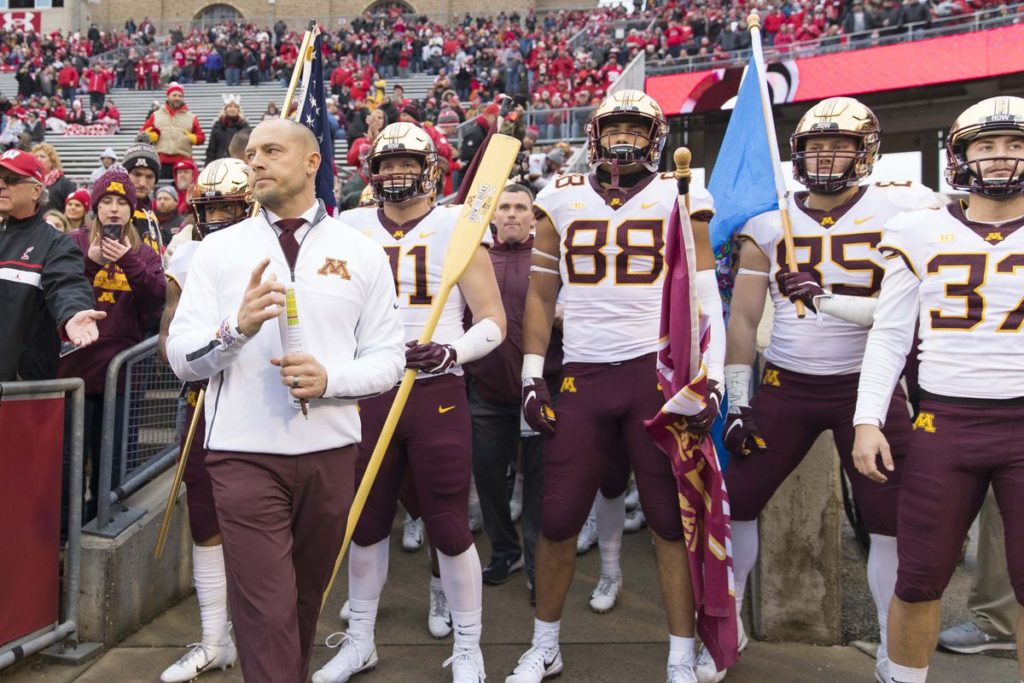It doesn’t seem that long ago that Clemson beat the socks off Alabama to capture the NCAA football crown. As over a foot of snow sits on the ground in Minnesota (with more on the way this week), it may be surprising to realize that spring football isn’t that far away, at all. Ryan Burns of Gopher Illustrated talked all things Gopher football on a recent episode of Minnesota Sports Weekly.
“We’re only a few weeks away now,” Burns said, “and considering the kind of February we’ve had, with all the snow and the Polar Vortex, it’s going to be a sight for sore eyes. Warmer temps are around the corner, the doldrums of winter are getting behind us, which is a good thing for Minnesota residents and for Gopher football.”Recruiting has basically wrapped up (for now). Burns said Gopher coaches spent roughly three weeks in January pounding the pavement on the recruiting trail. That second national signing day cut down on the number of recruits Gopher football signed this time around during the traditional signing day, which is the first Wednesday of February.
“Minnesota only signed one more scholarship player,” Burns said. “They’d signed 21 scholarship players during the early signing day in December. It’s the second year that college football had two signing days. I’d say roughly 70 percent of all college football recruits have signed during December.

“The Minnesota coaching staff should be back in the office this week and looking at more recruiting tape,” he added. “Just a couple weeks later, the staff will get started on their spring football season.”
How much time do these coaches spend on the road trying to build the future of the program? It’s astronomical. After the Gophers beat Wisconsin at the end of the regular season, head coach P.J. Fleck was out on the road 19 of the next 23 days recruiting, all the way up to the early National Signing Day. As Burns said, “There’s no rest for the weary.” Right after that signing day, the Gophers were off to Detroit and their Dec. 26 appearance in the Quick Lane Bowl.
“They (coaches) got a couple weeks off after the bowl and they were back out on the recruiting trail through late January and early February,” he said. “They get another week off and then it’s back to work figuring out who they want to recruit for the 2020 class, which is all juniors as we speak today. It’s spring football until April 15th, after which they’ll be back on the road till the end of May.

“Once that wraps up, their home with their families for 6-7 weeks,” Burns said. “Coaching is demanding. I know several Gopher coaches that consistently work 12-14-hour days and it’s tough being away from your family that much. When you’re out for a six-week stretch of recruiting, you’re home maybe one day every week. You better have an understanding better-half who’s willing to put up with the lifestyle.”
Looking at recruiting specifics, Burns said they had a few holes in the roster to fill. “They were trying to add more talent into a young team. The Gophers might have been the youngest team in the country last year. You always want to continue to add talent, especially at the quarterback position.
“It’s the position at which the Gophers have the biggest question marks on how the program takes the next step forward,” he added. “I’d argue they have as good of a stable of running backs that they’ve had in a long time, they have as good a wide receiver group they’ve had in a long time, and the Minnesota offensive line really flipped a switch in the last month of the season. The O line was a big reason the team took a big step forward late in the year.”
Minnesota signed two quarterbacks in the offseason. One was from out-of-state and was the highest-rated QB to sign with the Gophers in decades. His name is Jacob Clark and he’s from Rockwall, Texas. They also signed Cole Kramer, a quarterback from Eden Prairie, Minnesota. Burns said Fleck did “a good job” of filling his two biggest needs at quarterback and along the defensive line.
One of the most amazing things about recruiting under P.J. Fleck is how the Gopher program is getting recruits who are being chased by school in the Power 5 conferences. A good example is defensive lineman Rashad Cheney of Atlanta, Georgia. The 6-foot-2, 270-pound defensive tackle, a four-star recruit, had previously committed to play for both Georgia and Alabama in the SEC. However, he signed a letter of intent late last year to play football for the University of Minnesota.
“Any time that you’re able to get a kid who had committed to Alabama all the way up to Halloween of last year before deciding to look around,” Burns said, “I think Alabama’s defensive line is absolutely something you should try to emulate. Think about it, they annually send two or three guys off their defensive line to the NFL every year.
“Winning in the trenches every year is a big point of emphasis for defensive coordinator Joe Rossi,” he added. “I think they addressed that well.”
The Gopher football team took many Minnesota football fans by surprise, finishing 7-6 overall, getting three wins in the Big Ten Conference, and winning five of their seven home games. The goal of spring football is to make sure the program takes steps to keep things moving forward.
“The coaches want to make sure they can build on some things,” Burns said. “They want to make sure the players who had difficulties last year with certain aspects of their positions can get those things corrected by understanding the cause and correcting their technique. As much as they want to get the kids physically ready to go, it’s more about the mental aspect as Minnesota will continue to install new things both on offense and defense.”
He added, “Going into year three, they want to take things up a notch.”
The big headliner for Gopher football fans to watch in spring football is definitely at the quarterback position.
“You had Mankato native Zach Annexstad win the job out of Gopher football fall camp and then gets injured during the season,” Burns said. “Tanner Morgan then comes in to finish the season. Tanner started seven games and Zach started six. Neither one of them really did enough to pull away from one another.
“You also have the two freshmen quarterbacks coming in, both of whom graduated high school early,” he added. “They’re already enrolled on campus and will be there for workouts, as well as spring ball, trying to compete for that starting quarterback job. Fleck has said the quarterback job is wide open, but I say that Annexstad likely has the inside track. However, they’re all underclassmen, all 18-20 years old, and they’ll all grow and develop at a different pace, so we’ll see what happens.”
